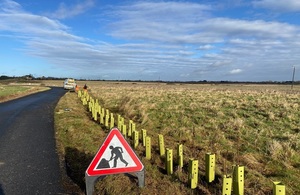More than 7,000 shrubs planted to combat climate change in Essex
Over 2,000 metres of hedgerow has been planted in Seawick and Leewick near Clacton to help store carbon.

Carbon catching hedges planted in Seawick and Leewick.
The hedges consist of more than 7,000 individual shrubs and have been planted at 3 separate locations. North and south of Beach Road in Seawick, north from Leewick Sewage Works and alongside the southern side of Leewick Depot.
Plants store carbon in the form of carbohydrates, for immediate and long-term growth. These are produced by photosynthesis, whereby they take carbon dioxide from the atmosphere. It is then turned it into sugars that go on to become leaves, stems, roots, and woody trunks.

The shrub planting forms part of the Environment Agency’s £1.1 million Seawick Sea Defence project.
Sarah Long, Senior Landscape Architect at the Environment Agency, said:
The newly planted hedgerows provide numerous environmental and practical benefits. They will improve air quality, provide food and shelter to local wildlife and reinforce the character of the local landscape.
We’ve deliberately used biodegradable plant guards to minimise the Seawick and Leewick project’s carbon impact, fully committed to carbon capture and habitat enhancement.
These hedges are a fantastic example of a nature-based solution that helps to combat climate change.
The work forms part of the Environment Agency’s £1.1 million Seawick Sea Defence project, to improve the resilience of the sea defences in the area. This will better protect from sea flooding and the severe impact that it can have on people, properties and the local economy, which relies heavily on tourism.
Additional information
- The planting work has been carried out by Environment Agency contractor Ground Control.
- To find out more about the Seawick Sea Defence Project visit: https://www.gov.uk/government/news/seawick-sea-defences-project